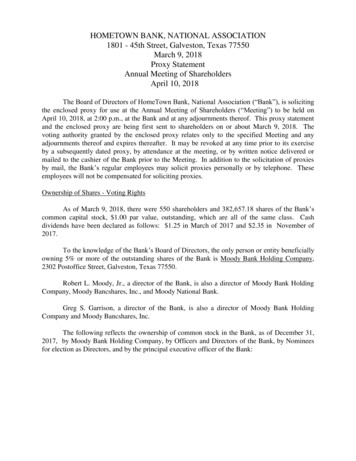
Transcription
Breakingthe BiasHow gender equalitywill transform economies,finance and business
Executive Summary1234EconomyCredit riskCorporate actionSustainable financeWomen bore the brunt of the COVID-19pandemic as disruptions to schooling andchildcare outside the home exacerbated thedownturn in female-dominated industries.Board-level gender diversity is correlated withhigher credit ratings, according to Moody’sInvestors Service. The presence of womenon boards – and the diversity of opinion theybring – supports good corporate governance,which is positive for credit quality.No corporate sectors achieved managementlevel gender parity in 2020 and almost half ofall sectors have management teams that are,on average, less than 25% female, accordingto data from Moody’s ESG Solutions.Debt instruments that finance projects tosupport gender equity – which encompassesissues of fairness, opportunity and access –will grow in number amid increasing investordemand and regulatory pressure to discloseinformation on gender pay gaps and boardlevel diversity, according to Moody’sESG Solutions.»»For example, the gap between male andfemale labor participation in the US iswider than in Canada, the UK, Germany,Sweden and Australia, according toMoody’s Analytics.Implementation of family-friendlypolicies that are available in othercountries, such as guaranteed paid familyleave and subsidized childcare, couldboost US GDP growth by almost 1trillion in the next 10 years, or 4% aboveour baseline forecast.»Board-level gender diversity graduallydeclines down the rating scale.»Likewise, companies with positivegovernance characteristics have a higherproportion of women on boards. Womenrepresent 35% of the boards of thecompanies with positive governancecharacteristics as reflected by theirgovernance issuer profile scores, whilecompanies with very highly negativeexposure to governance considerationshave only about 21% of the board seatscomposed by women.»»Information technology, industrials andenergy rank particularly low in terms ofthe percentage of women in managementpositions and the proportion of companiesthat disclose measures to support equallabor force participation; the luxury goodsand cosmetics sector is the strongestperformer, followed by financial services.Measures that can improve equalparticipation include paid maternity leave,flexible work hours and childcare.»Sustainability bonds that combine greenand social projects are emerging as theinstrument of choice for financing genderrelated projects.»Use-of-proceeds social bonds will remain akey instrument in funding gender equityfocused projects.»Sustainability-linked bonds are emergingas an alternative debt structure asissuers embed gender equity in theirorganizations’ financing strategies.Breaking the Bias How gender equality will transform economies, finance and business2
ECONOMYWhat would higherfemale labor forceparticipation mean forthe US economy?
Higher rates of female labor force participation benefit economic growthCOVID-19 pandemic hurt women more»»»Around the globe, women bore the brunt of theCOVID-19 pandemic as disruptions to schooling andchildcare outside the home exacerbated the downturn infemale-dominated industries, like education, healthcareand food services, according to Moody’s Analytics.»»Participation rates, prime-age women,December 2019 100.SWEDEN100While the participation gap has shrunk in several othernations since the pandemic began, it has widened in the US.90.7101.1100UNITED KINGDOMDec 2019 COVID low Nov 2021Dec 2019 COVID low Oct 202110098.598.6100.4GERMANY99.6Dec 2019 COVID low100During the past year, the recovery in US female laborforce participation has lagged, with participationremaining below pre-pandemic levels.While labor force participation rates of prime-age (25-54years) women lag those of men around the world, the UShas the widest gap in our sample group.Dec 2019 COVID low Dec 2021CANADAA higher proportion of women left the workforce in theUS and Canada than in the UK, Germany, Sweden andAustralia, partly because policies are less supportive thanin those four countries.US women have fallen further behind theirmale counterparts»US women are further behind 99.3Jul 202199.8UNITED STATESDec 2019 COVID low Dec 202110095.797.8 and gap with men has only widenedGap between prime-age men’s and women’s participation rates, in percentage points20217.820199.1The lack of family-friendly policies in the US keeps moreprime-age women out of the labor force during theirmost productive years compared to other 98.66.4Canada201920214.0Dec 2019 COVID low Nov .9AUSTRALIAUSTop exhibit: COVID low denotes April 2020 for Canada and Sweden, May 2020 for Australia, December 2020 for the UK, January 2021 for Germany and March 2021 for the US.Bottom exhibit: Year-end 2019 for all countries; 2021 is as of December (Sweden and US), November (Canada and Australia), October (UK) and July (Germany).Sources: International Labour Organization, OECD, Moody’s Analytics.Back to Executive SummaryBreaking the Bias How gender equality will transform economies, finance and business4
A population cohort analysis shows the effect of US demographicson labor force participation»Holding participation constant at 2019 rates for age and sex allows us to seehow demographic shifts alone will impact the labor force over the next 30 years.»The prime working age population will fall over the next three decades as BabyBoomers age into retirement and a much smaller working-age cohort replacesthem. Lower levels of immigration will be unable to offset the decline.»Findings from Moody’s Analytics show how narrowing the gender gap in laborforce participation would boost economic growth.Family-friendly policies could boost output»Family-friendly policies that exist in other developed nations such as guaranteedpaid family leave, childcare subsidies or credits and universal pre-kindergartenwould allow more prime-age women to work.»If these policies went into effect immediately and prime-age womenparticipated in the workforce at the same rate as in other developed nations,real US GDP would be almost 1 trillion higher in the next 10 years, or 4%above our baseline forecast.»Even if women close only half of the 10-percentage-point gap with men’sparticipation, GDP would be 2% higher in the next 10 years than our baseline.Demographics overwhelm any scenario but output could be significantly higherUS participation rate, %, under various assumptions.US GDP under various assumptions (in 2010 dollars)BaselinePre-pandemic peakHalfway to men’s ratesOther developed nations’ rateBaselineHalfway to men’s participationOther developed nations65YEARS6463TRILLIONS20192028204020442052 19 23 30 32 37 19 24 30 33 38 19 24 31 34 406261605920212025202920332037Sources: US Census Bureau, US Bureau of Labor Statistics, Moody’s Analytics.Back to Executive Summary204120452049Sources: US Bureau of Economic Analysis, Moody’s Analytics.Breaking the Bias How gender equality will transform economies, finance and business5
CREDIT RISKIs there a linkbetween boardroomgender diversity andcredit ratings?
Board-level gender diversity amongNorth American and Europeancompanies1 rated by Moody’sInvestors Service tends to be higher forcompanies with higher credit ratings.Although the positive correlationbetween boardroom gender diversityand credit ratings falls short ofdemonstrating direct causation, weconsider the presence of women onboards – and the diversity of opinionthey bring – as being supportive of goodcorporate governance, which is positivefor credit quality.Gender diversity increased across mostof the rating categories during the pasttwo years (see exhibit at right). Thistrend is likely to continue, driven bynew diversity mandates and push fromprominent stakeholders, such as proxyadvisory firms and asset managerslike BlackRock and State Street GlobalAdvisors. In addition, stricter disclosurerequirements, including the approvalof Nasdaq Inc.’s proposal last year, willlikely result in further gains.NORTH AMERICAEUROPEMOODY’S CREDITRATING CATEGORIES35.3Aaa27.633.4Aa26.630.633.7 36.1A25.527.3Avg. % of Women on Boards201920202022Baa23.524.834.9 37.4Ba18.822.814.918.130.214.327.0BCaa35.231.127.9 29.519.424.5Data as of 31 January 2022. Excludes rating categories with fewer than five rated issuers. Sources: Moody’s Investors Service and Bloomberg.1Cohort of companies assessed in our March 2020 report about boardroom gender diversity in Europe and our September 2019 report aboutboardroom gender diversity in North America (US and Canada).Back to Executive SummaryBreaking the Bias How gender equality will transform economies, finance and business7
In addition, our analysis found a positive correlation between boardroom genderdiversity and our governance issuer profile scores (G-IPS)3 for the 387 companiesin our cohort that have been scored to date. Women account for an average of35% of the boards of companies with positive governance characteristics (G-1)and occupy only about 21% of the board seats of companies with very highlynegative exposure to governance considerations (G-5).Government mandates and pressure from large institutionalinvestors and asset managers have increased gender diversityon the boards of 1,301 rated North American and Europeancompanies. In the past two years, the aggregate share ofcorporate board seats held by women rose to 29% from 24%,according to Moody’s Investors Service.2In North American companies, board seats occupied bywomen rose to 27% from 22% in 2019. While in Europe,the gains were more modest, from 31% in 2020 to 35% in2022, likely related to the fact that they came off a higherbase. The UK and more than half of the member countriesof the European Union have mandates or nonbindingtargets for board-level gender diversity.The data also suggests that higher credit ratings are notonly correlated with a higher proportion of women onboards but also with a higher percentage of women inC-suite executive positions.2To ensure that our analysis is not skewed by shifts in cohort composition or smallsample sizes, we focused on rated, publicly traded companies for which data is availableand limited our analysis of rating categories to those with at least five rated ssuers fromour cohort. Companies that we no longer rate or are now privately held have beenremoved from the 2019-2020 cohort for the purposes of this analysis.Back to Executive Summary2019 / 20202022GOVERNANCE ISSUERPROFILE SCORES.24%29%PositionsPositions3,372AVERAGE % OF WOMEN ON BOARDS BY 3,793Board Positions13,938G-425.0%Moderately negativeBoard PositionsG-321.4%G-520.6%Highly negative76%71%PositionsPositions10,4249,902Very highly negative3See General Principles for Assessing Environmental, Social and Governance Risks MethodologySource: Moody’s Investors ServiceBreaking the Bias How gender equality will transform economies, finance and business8
C O R P O R AT E A C T I O NHow are corporationsintegrating genderequality into theirbusinesses?
Gender equality will be critical in achieving the the UN Sustainable DevelopmentGoals (SDGs), the 17 interconnected, social, economic, environmental andinstitutional goals that all UN member states have agreed to achieve by 2030.The private sector is essential to delivering the SDGs, not least SDG 5, which seeksto achieve gender equality and empower all women and girls (see table below).Despite growing corporate recognition of the importance of gender equality,research from Moody’s ESG Solutions finds mixed outcomes across sectors interms of the percentage of women in management positions and the supportivesteps taken to achieve more equal labor force participation, such as providing paidmaternity leave, flexible work hours and childcare. Moody’s ESG Solutions dataalso finds that cases of gender-related controversies nearly doubled during 2021.Improving gender-related business practices will not only mitigate harm associatedwith gender inequality, but also help advance equal participation of women inleadership and decision-making.SDG 5: Achieve gender equality and empower all women and girls,selected targets5.2Eliminate all forms of violence against all women and girls in the publicand private spheres, including trafficking and sexual and other typesof exploitation.5.5Ensure women’s full and effective participation and equal opportunitiesfor leadership at all levels of decision-making in political, economicand public life.5.CAdopt and strengthen sound policies and enforceable legislation forthe promotion of gender equality and the empowerment of all womenand girls at all levels.Source: United NationsBack to Executive SummaryBreaking the Bias How gender equality will transform economies, finance and business10
Despite growing corporate recognition of the importance of gender equality, outcomes are mixed across global sectors interms of the percentage of women in management positions and supportive steps taken to achieve more equal labor forceparticipation, such as providing paid maternity leave, flexible work hours and childcare.Percentage of women in management positions with average percentage of companies disclosingequal participation measures (including flexible work hours, paid maternity leave and childcare)% of women in management positions41%Average % of equal participation measures39%40%39%36%34%32%30%22%22%SECTOR16%27% 27%26%25%17%Energy17%18%19%22%19%20%22%45%We also find that more than half of all global gender-related controversiesoccur in sectors with 20% or lower equal participation measures performance.Furthermore, our research finds that corporate gender-related controversies almostdoubled to 117 in 2021 from 64 in 2020 (see exhibit below), with pay issues,gender discrimination and sexual assault making up the majority of cases.4 Thissharp increase can be attributed in part to labor-related pandemic headwinds thatdisproportionately hurt women and to greater focus on gender discrimination andsexual harassment that is, in turn, improving the disclosure of such incidents.23% 24%33%Gender-related controversies, 2016-202135%YEAR28%24%21%15%Real estateHotels, leisuregoods & TransportationRetailHealth careFood, beverageMedia &AutomobilesLuxury goods& tobaccoentertainment& cosmeticsSource: Moody's ESG SolutionsWhen considering the percentage of women in management with our assessment of the measures that can improve equalparticipation, the information technology, industrials and energy sectors perform poorly, with management teams that are only22% female and less than 20% of companies disclosing equal participation measures. The luxury goods and cosmetics sector is thestrongest performer, combining the highest percentage of women in management positions (41%) with the highest proportion ofcompanies disclosing equal participation measures (45%).Back to Executive SummaryNUMBER OF Source: Moody’s ESG SolutionsOverall, the mixed picture of performance across sectors suggests a lack ofsystematic approaches to address gender equality challenges in the workplace.Companies in sectors that are able to offer stronger equal participation measureswill improve their potential to increase the percentage of women in executiveand senior management positions, enhancing their ability to attract and retainemployees, build diverse organizations and leadership and contribute to SDG 5.4Moody’s ESG Solutions’ Controversy Risk Assessment Database captures over 20,000 cases logged and analyzedacross a broad range of ESG issues.Breaking the Bias How gender equality will transform economies, finance and business11
S U S TA I N A B L E F I N A N C EHow can the capitalmarkets promotegender equity?
With sustainability becoming an increasingly important theme in global capitalmarkets, Moody’s ESG Solutions expects issuance of green, social, sustainabilityand sustainability-linked (GSSS) bonds to hit a record 1.35 trillion globally in2022.5 Debt instruments that finance projects to support gender equity will growin number amid increasing investor demand and mounting regulatory pressure oninvestors and companies to disclose information on gender pay gaps and diversityon corporate boards.6Against this backdrop, there is a greater need for financing aimed at alleviatingissues that stem from gender inequality. In 2021, proceeds from about 22 billionof GSSS bonds were earmarked – in whole or in part – for the financing of projectstied to SDG 5 for the achievement of gender equality and female empowerment.Such volumes have grown steadily since 2016, with a cumulative 70 billion issuedsince that year.Primary labeled debt instruments of choice are sustainability bonds – where issuerscan combine environmental objectives with social objectives such as gender equity– and social bonds where gender can be the sole or primary focus of the bond. Thereis also growing use of sustainability-linked bonds to address gender equity goals,which enable issuers to incorporate gender-related targets into their financingstructures with the cost of capital directly tied to the achievement of such targets.56See Sustainable bonds to hit record 1.35 trillion in 2022, Moody’s ESG Solutions, January 2022.See, for example, Corporate sustainability reporting, European Commission.Back to Executive SummarySustainable bond issuance linked to SDG 5 totals 70 billion since 2016Green bondSocial bondSustainability bondSustainability-linked bond2016 3.72017 4.4 2.72018 2.92019 2.82020 1.72021 0.6 0 3.2 2.7 0.1 1.9 5.1 4.1 12.3 5.7 14.3 5 10 0.8 15 20US billionsSources: Moody’s ESG Solutions, Environmental Finance Bond Database.Breaking the Bias How gender equality will transform economies, finance and business13
Continued growth in such issuance is critical given that the socioeconomic impactof the COVID-19 pandemic has disproportionately hindered progress in closing thegap in gender equality.7The promotion of gender equity is prevalent in a variety ofsustainable debt instruments, with sustainability bonds thatcombine green and social projects emerging as the instrument ofchoice for financing gender-related projects.For example, the Republic of Benin issued a 500 million ( 591 million) SDGbond in July 2021 – the first of its kind in Africa – with proceeds from the issuancefinancing a wide array of environmental and social projects.8 Among the list ofeligible social projects are gender equality initiatives focused on improving thehealth of young women and women with limited access to reproductive healthcare;expanding access to education for young girls; and supporting female entrepreneurs.Use-of-proceeds social bonds will remain a key instrument infunding gender equity focused projects.In Colombia, for example, Banco Davivienda issued a gender-focused social bond inAugust 2020 for COP362.5 million (about 100 million).9 This bond was the first ofits kind in South America, with clearly defined gender-equity objectives aligned withinternational standards. Proceeds from the bond are earmarked for loans to eligiblewomen-led and owned small and medium enterprises in Colombia and socialinterest housing loans that seek to benefit first-time female home buyers withlow incomes.Sustainability-linked bonds are emerging as an alternative debtstructure as issuers embed gender equity in their organizations’financing strategies.Schneider Electric, a French global electrical systems company, issued a 650million (about 769 million) convertible sustainability-linked bond (SLB)in November 2020.10 The SLB links environmental and social sustainabilityperformance goals through three sustainability targets: deliver 800 million tons ofsaved and avoided of CO2 emissions to customers; meet gender diversity targetsfor the hiring of front-line managers and leadership teams; and train one millionunderprivileged people in energy management.Despite the steady increase in issuance tied to SDG 5 in recent years, there ismuch work to be done and ample room for market growth. Of the sustainabledebt issuances citing projects linked to SDGs since 2016, Moody’s ESG Solutionsestimates that just over 1% of proceeds have been allocated to SDG 5, with asignificantly higher share of issuance going to other projects such as for climatemitigation efforts. This aligns with the findings from a recent OECD paper whichconcludes that investments in gender equality and women’s empowerment arelagging behind investments for most other goals.11See Development finance for gender equality and women’s empowerment: a 2021 snapshot, OECD, April 2021.For more information, see Second Party Opinion from V.E, July 2021. V.E is now part of Moody’s ESG Solutions Group.9For more information, see Second Party Opinion from Vigeo Eiris, July 2020. Vigeo Eiris is now part of Moody’s ESG Solutions Group.10For more information, see Second Party Opinion from V.E, November 2020. V.E is now part of Moody’s ESG Solutions Group.11See Putting Finance to Work for Gender Equality and Women’s Empowerment – the Way Forward, OECD Development Policy Papers, January 2020.78Back to Executive SummaryBreaking the Bias How gender equality will transform economies, finance and business14
Nevertheless, there are initiatives underway globally to promote thecontinued advancement of gender equity in capital markets. In November2021, the International Capital Market Association, the International FinanceCorporation and UN Women published a guide to using sustainable debtfor gender equality which highlights the types of gender projects that canbe financed and provides examples of gender-based targets for issuersof sustainability-linked bonds.12 Such efforts will continue in light of thesignificant financing gap to meet gender equity goals.UN SDG ValueSDG 1SDG 2SDG 3SDG 4SDG 5SDG 6SDG 7SDG 8SDG 9SDG 10SDG 11SDG 12SDG 13SDG 14SDG 15SDG 16SDG 1712UN SDGsGoal 1: No povertyGoal 2: No hungerGoal 3: Good health and well-beingGoal 4: Quality educationGoal 5: Gender equalityGoal 6: Clean water and sanitationGoal 7: Affordable and clean energyGoal 8: Decent work and economic growthGoal 9: Industry, innovation and infrastructureGoal 10: Reduced inequalitiesGoal 11: Sustainable cities and communitiesGoal 12: Responsible consumption and productionGoal 13: Climate actionGoal 14: Life below waterGoal 15: Life on landGoal 16: Peace, justice and strong institutionsGoal 17: Partnerships for the goalsSee Bonds to bridge the gender gap: A practitioner’s guide to using sustainable debt for gender equality, UN Women,November 2021.Back to Executive SummaryDespite recent growth only 1% of sustainablebonds referencing SDGs have been tied to SDG 5SDG 4SDG 154%4%SDG 161%SDG 1313%SDG 51%SDG 103%SDG 98%SDG 1115%SDG 6SDG 74%5%SDG 1216%SDG 14SDG 86%SDG 33%12%SDG 171%SDG 21%SDG 13%Covers years 2016-2021. The size of each bubble represents the approximate share of GSSS bond proceeds (in US billions) dedicated to each SDG. Assumes equal deployment of bondproceeds to SDGs where multiple SDGs are cited. Sources: Moody’s ESG Solutions, Environmental Finance Bond DatabaseBreaking the Bias How gender equality will transform economies, finance and business15
moodys.com/whm 2022 Moody’s Corporation, Moody’s Investors Service, Inc., Moody’s Analytics, Inc. and/or their licensors and affiliates (collectively, “MOODY’S”). All rights reserved.
Sources: US Census Bureau, US Bureau of Labor Statistics, Moody's Analytics. Sources: US Bureau of Economic Analysis, Moody's Analytics. but output could be significantly higher US GDP under various assumptions (in 2010 dollars) Baseline Halfway to men's participation Other developed nations TRILLIONS YEARS 2019 19 19 19 2028 23 .










